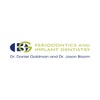Welcome to our comprehensive guide on the care provided by periodontist Armadale! In this blog post, we will explore the world of periodontology and highlight the benefits of seeking comprehensive periodontal care. Dental health plays a crucial role in our overall well-being, and periodontal disease can have serious consequences if left untreated or poorly managed.
By understanding the importance of early detection, utilizing diagnostic tools and techniques, exploring various treatment options, and maintaining proper follow-up care, we can take proactive steps to ensure a healthier smile and overall oral health.
1. Understanding Periodontal Disease:
Periodontal disease, also known as gum disease, is a chronic inflammatory condition that affects the supporting structures of teeth, including the gums, periodontal ligament, and alveolar bone. It is caused by the buildup of plaque, a sticky film of bacteria that forms on teeth, leading to gum inflammation and, if left untreated, can progress to more severe forms of periodontal disease. Common causes of gum disease include poor oral hygiene, smoking, hormonal changes, certain medications, and genetic predisposition.
Untreated or poorly managed periodontal disease can have serious consequences. It can lead to gum recession, tooth loss, and even systemic health problems like heart disease, diabetes, and respiratory issues. Therefore, it is essential to recognize the signs of periodontal disease and seek professional help as soon as possible.
Early detection and preventive measures play a crucial role in preventing the progression of periodontal disease. Regular dental check-ups and professional cleanings can help identify and address any signs of gum disease before they escalate.
2. Diagnostic Tools and Techniques:
Periodontists utilize various diagnostic tools and techniques to assess the severity of periodontal disease and develop an appropriate treatment plan. These tools include X-rays, probing, and clinical examinations.
X-rays (radiographs) provide a comprehensive view of the teeth and supporting structures. They help identify bone loss, detect hidden infections, and evaluate the overall health of the mouth. Probing involves measuring the depth of the space between the gums and teeth. This helps determine the presence and severity of periodontal pockets and assess the extent of gum tissue attachment loss. Clinical examinations involve a thorough visual inspection of the mouth, checking for signs of gum inflammation, bleeding, or recession.
It is understandable that some readers may have concerns or misconceptions about these diagnostic procedures. However, it is important to note that these tools are essential for accurate diagnosis and treatment planning. They are safe, painless, and help periodontist Armadale provide the best possible care.
3. Treatment Options:
- Non-Surgical Treatments:
Non-surgical treatments are typically the first line of defense for managing periodontal disease, especially in its early to moderate stages. These treatments aim to remove plaque and bacteria from the teeth and gums, reduce inflammation, and promote healing. Some common non-surgical treatment methods include scaling and root planing, antimicrobial therapy, and laser treatments.

Scaling and root planing involve deep cleaning of the teeth and gums to remove plaque, tartar, and bacteria from the root surfaces. This procedure helps eliminate sources of infection and promotes gum reattachment to the tooth surface. Antimicrobial therapy may involve the use of mouth rinses, gels, or antibiotics to target specific bacteria causing gum disease. Laser treatments are also gaining popularity as they can effectively remove infected tissue and promote gum regeneration.
To support non-surgical treatments, maintaining good oral hygiene at home is crucial. This includes brushing twice a day with a soft-bristled toothbrush, using antimicrobial mouth rinses, flossing daily, and adopting a healthy diet low in sugary foods and beverages.
- Surgical Treatments:
In more severe cases of periodontal disease, surgical intervention may be necessary. These advanced surgical options aim to address deep pockets, restore damaged tissue, and regenerate lost bone and gum tissue.
Flap surgery involves lifting the gums to access the roots of the teeth for a thorough cleaning. This procedure allows the periodontist to remove tartar and bacteria from the root surfaces, reduce pocket depth, and reposition the gums to promote healing and prevent future infections. Bone grafting may be required to restore lost bone tissue, while gum tissue regeneration techniques are utilized to rebuild damaged gum tissue.
It is natural to have concerns about pain management, recovery time, and long-term outcomes associated with surgical treatments. Rest assured, periodontists are highly trained professionals who prioritize patient comfort and ensure effective pain management. Recovery times vary depending on the type of procedure, but periodontists will provide detailed post-operative instructions to support healing and minimize discomfort. Long-term outcomes are generally positive, with restored oral health and improved overall well-being.
4. Maintenance and Follow-up Care:
After undergoing periodontal treatment, it is crucial to maintain regular follow-up appointments with a periodontist. These visits allow the periodontist to monitor the progress of the treatment, assess oral health, and address any concerns or complications that may arise.
Post-treatment care routines are equally important in maintaining optimal oral health. Periodontists will provide personalized instructions on proper oral hygiene techniques, including brushing, flossing, and the use of specialized tools if necessary. It is vital to adhere to these instructions to prevent the recurrence or progression of periodontal disease.
In addition to routine oral hygiene practices, lifestyle changes can also contribute to maintaining oral health. Quitting smoking, reducing stress, and adopting a well-balanced diet can have a positive impact on overall oral health.
Conclusion:
Comprehensive periodontal care is essential for maintaining healthy gums and teeth. Understanding the causes, consequences, and treatment options of periodontal disease empowers individuals to take control of their oral health. By seeking professional help from a qualified periodontist balwyn, individuals can receive personalized care, tailored treatment plans, and long-term guidance on maintaining oral health.


No comments yet